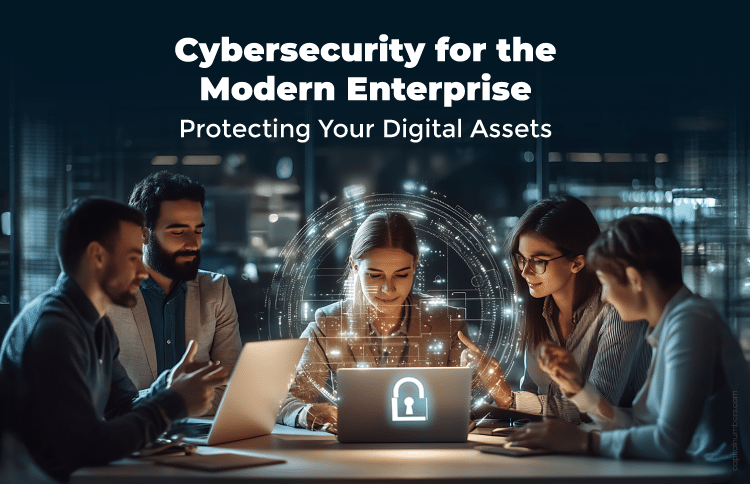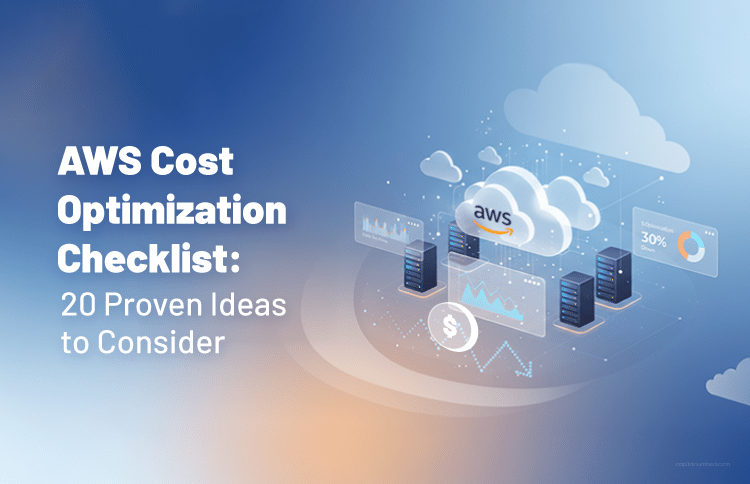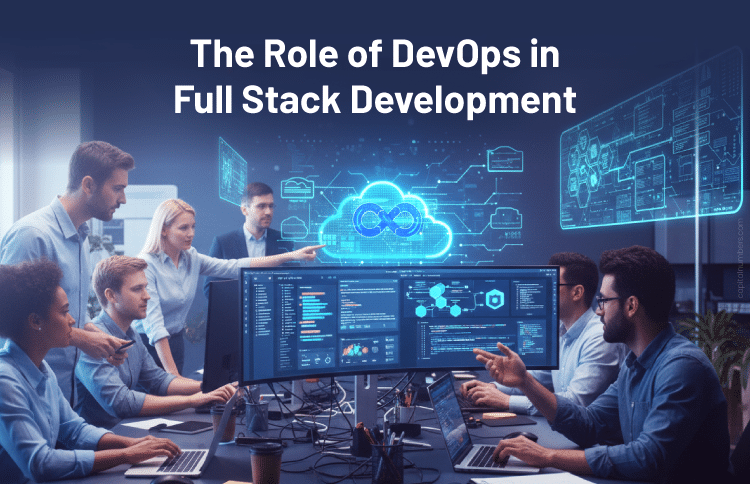Cybersecurity for the Modern Enterprise: Protecting Your Digital Assets
Table of Contents
Imagine this: you’re running a thriving business, and everything’s humming along smoothly. Your team’s collaborating in the cloud, your customers are shopping online, and your data’s flowing like a well-oiled machine. Then, out of nowhere, a cyberattack hits. Your sensitive data – customer info, financial records, trade secrets – is stolen, your systems grind to a halt, and your reputation takes a nosedive.
Sounds like a nightmare, right? Unfortunately, for many modern enterprises, this scenario is all too real.
In 2025, cyber threats are evolving faster than ever. From ransomware to phishing scams powered by artificial intelligence, cybercriminals are getting smarter, and businesses are paying the price.
In this blog post, I’ll walk you through everything you need to know about protecting your digital assets in today’s fast-paced, threat-filled world. We’ll cover the latest cyber threats, practical strategies to safeguard your business, and emerging trends that could shape the future of enterprise security. Whether you’re a small business owner or a C-suite executive at a Fortune 500 company, this guide will give you actionable insights to stay one step ahead of the bad guys. Let’s dive in!
The Cybersecurity Landscape in 2025: What’s at Stake?
Cybersecurity isn’t just about protecting your computers anymore – it’s about safeguarding your entire digital ecosystem. Your digital assets include customer data, intellectual property, financial records, and even your brand’s reputation. A single breach can cost millions in damages, lost business, and legal fees, not to mention the trust of your customers.
Why Enterprises Are Prime Targets
Modern enterprises are juicy targets for cybercriminals because they handle massive amounts of sensitive data. Here’s why:
- Data is the new gold: Customer information, proprietary algorithms, and trade secrets are incredibly valuable on the dark web.
- Complex systems: Enterprises often use a mix of cloud platforms, IoT devices, and remote work tools, creating multiple entry points for attackers.
- High stakes: A successful attack on a large organization can yield a bigger payout for hackers, whether through ransom or stolen data.
The Biggest Cybersecurity Threats Facing Enterprises in 2025
To protect your digital assets, you first need to understand what you’re up against. Here are the top threats enterprises face today, along with real-world examples:
1. Ransomware: The Digital Extortion Racket
Ransomware is like a digital kidnapper holding your data hostage. Attackers encrypt your files and demand payment (often in cryptocurrency) to unlock them. In 2025, ransomware is more sophisticated, with hackers targeting specific industries like healthcare and retail. For example, the Marks and Spencer cyberattack in May 2025 disrupted operations and made headlines for weeks.
- How It Works: Attackers exploit vulnerabilities in software or trick employees into clicking malicious links.
- Impact: Downtime, data loss, and hefty ransoms can cripple a business.
- Example: The 2024 attack on Mainline Health exposed data of over 100,000 individuals, showing how even well-prepared organizations can fall victim.
2. Phishing and Social Engineering: The Human Weak Link
Phishing attacks are emails, texts, or even voice calls designed to trick employees into giving up sensitive information. With AI, these attacks are getting scarily convincing – think deepfake voice calls mimicking your CEO.
- How It Works: Attackers pose as trusted sources (e.g., a bank or IT department) to steal credentials or install malware.
- Impact: Stolen credentials can lead to unauthorized access to your systems.
- Example: The “Wedding Invitation” phishing campaign in India used culturally relevant lures to spread malware via Android devices.
3. Supply Chain Attacks: Your Vendors Are Your Weakest Link
If your vendors aren’t secure, neither are you. Supply chain attacks target third-party partners to gain access to your systems.
- How It Works: Hackers compromise a vendor’s systems, then use their access to infiltrate your network.
- Impact: Breaches can spread across multiple organizations, amplifying damage.
4. AI-Powered Attacks: The Future Is Here
Artificial intelligence is a double-edged sword. While it helps defenders detect threats, hackers are using AI to craft sophisticated attacks, like prompt injection against AI-powered security tools.
- How It Works: AI generates realistic phishing emails, deepfake videos, or automated exploits.
- Impact: These attacks are harder to detect and can scale rapidly.
5. Quantum Computing: The Next Frontier
Here’s something you won’t find in most competitor blogs: the looming threat of quantum computing. Quantum computers, expected to become more accessible by 2030, could break current encryption methods, rendering much of today’s cybersecurity obsolete.
- How It Works: Quantum computers can solve complex mathematical problems (like cracking RSA encryption) in seconds.
- Impact: Sensitive data encrypted today could be decrypted in the future, a concept called “harvest now, decrypt later.”
- Example: While no major quantum breaches have occurred yet, experts warn that enterprises must start adopting quantum-resistant algorithms now.
Building a Robust Cybersecurity Strategy: A Step-by-Step Guide

Now that you know the threats, let’s talk about how to protect your enterprise. Here’s a practical, step-by-step framework to secure your digital assets. Unlike competitor blogs, we’ll focus on actionable, cost-effective solutions that work for businesses of all sizes.
Step 1: Assess Your Risks
You can’t protect what you don’t understand. Start by conducting a risk assessment:
- Map Your Assets: Identify all digital assets, including data, software, and hardware.
- Identify Vulnerabilities: Use tools like vulnerability scanners to find weak spots in your systems.
- Evaluate Threats: Consider which threats (e.g., ransomware, phishing) are most likely to target your industry.
Pro Tip: Engage a third-party cybersecurity firm for an unbiased assessment. Smaller businesses can use free tools like NIST’s Cybersecurity Framework to get started.
Step 2: Implement Zero Trust Architecture
Zero trust is a buzzword, but it’s also a game-changer. The idea is simple: trust no one, verify everything. Unlike traditional security models that assume internal users are safe, zero trust requires continuous verification.
- Key Components:
- Multi-factor authentication (MFA) for all users.
- Network segmentation to limit access to sensitive areas.
- Real-time monitoring to detect suspicious activity.
- Why It Works: Zero trust minimizes the damage from compromised accounts or insider threats.
Step 3: Train Your Employees
Your employees are your first line of defense – and your biggest vulnerability. A single click on a phishing email can bring down your systems. Invest in regular, engaging training:
- What to Teach:
- How to spot phishing emails (e.g., check for misspellings or unusual domains).
- Safe password practices (e.g., use a password manager).
- How to report suspicious activity.
- Make It Fun: Use gamified training or simulated phishing attacks to keep employees engaged.
- New Insight: Consider employee well-being. Stressed or overworked employees are more likely to make mistakes. Offer mental health support to reduce burnout-related errors.
Step 4: Secure Your Supply Chain
Vendors are a weak link, but you can minimize the risk:
- Vet Vendors Thoroughly: Review their security policies and compliance certifications.
- Use Contracts: Include cybersecurity clauses in vendor agreements.
- Monitor Continuously: Use tools like UpGuard to track vendor security in real time.
Step 5: Invest in Modern Tools
Cybersecurity tools have come a long way. Here are some must-haves for 2025:
- Endpoint Protection: Solutions like CrowdStrike’s Falcon platform detect and prevent attacks on devices.
- SIEM Systems: Security Information and Event Management (SIEM) tools like Splunk provide real-time threat detection.
- AI-Driven Analytics: Use AI to identify patterns and predict attacks before they happen.
- Backup Solutions: Regular, encrypted backups can save you from ransomware.
- Budget Tip: Small businesses can start with open-source tools like Wazuh for SIEM or ClamAV for antivirus.
Step 6: Prepare for the Inevitable
No system is 100% secure. Prepare for a breach with an incident response plan:
- Create a Playbook: Outline steps for identifying, containing, and recovering from a breach.
- Test Regularly: Run tabletop exercises to simulate attacks.
- Communicate Clearly: Have a plan to notify customers, regulators, and the media.
You May Also Read: Don’t Get Hacked: Essential Software Security Checklist for Developers
Emerging Trends to Watch in 2025 and Beyond
Cybersecurity is a moving target, and staying ahead means keeping an eye on the future. Here are some trends that could shape enterprise security:
1. AI as Defender and Attacker
AI is transforming cybersecurity. On the defense side, AI tools can analyze massive datasets to spot anomalies. On the attack side, hackers are using AI to craft personalized phishing campaigns. Enterprises must invest in AI-driven defenses while training employees to recognize AI-generated threats.
2. Quantum-Resistant Cryptography
As quantum computing looms, enterprises need to adopt quantum-resistant algorithms. The National Institute of Standards and Technology (NIST) is already standardizing these algorithms. Start transitioning now to protect data from future decryption.
3. Regulatory Pressure
Governments are cracking down on cybersecurity lapses. Stay compliant by aligning with frameworks like GDPR or NIST.
4. Human-Centric Security
The human element is critical. Proofpoint’s 2025 trends report highlights the need for people-centric solutions, like training programs that address human error and insider threats.
Easy Action Steps – Techy, but Not Jargony
| Step | What You Do | Why It Helps |
|---|---|---|
| Track cloud keywords | Tag your content and tools with buzzwords above | Helps people find and trust your blog – and helps recruiters find your team |
| Start with MFA everywhere | Especially for admins and cloud apps | Simple, huge win |
| Deploy Zero-Trust Kubernetes or network micro-segments | Break networks into mini-zones | If an attacker gets in, they stay stuck in one spot |
| Subscribe to a CTEM tool or MDR provider | Watch for threats all the time | You don’t have to hire 24/7 staff |
| Build an Incident Runbook | Step by step: who calls whom, what tools, what to fix | Reduces chaos during real threats |
| Train with phishy fun quizzes weekly | Keep everyone alert without scaring them | Builds a culture of awareness |
Culture Beats Tech Any Day
At the end of the day, your people – not your software – are the strongest defense you have. Firewalls and fancy tools can’t always stop a careless click, but a smart, alert team can. That’s why creating a strong security culture matters more than just buying more tech.
- Your team is the real “human firewall.”
Mistakes happen when people aren’t paying attention, not because tools fail. Train your team in a way that feels real, easy to understand, and maybe even a little fun. If training makes them laugh, they’ll remember it better than a boring lecture. - Make cybersecurity everyone’s job.
Security shouldn’t live only in the IT department. Bring it into everyday conversations – during team meetings, quick chats, even Slack threads. A simple “Hey, double-check that link before you click” can turn into a healthy habit across the whole company. - Reward people for being cautious.
Instead of scaring employees with endless warnings, celebrate when they do the right thing. Did someone flag a suspicious email? Give them a shout-out in the team meeting! Recognition builds confidence and makes people want to stay alert, without the stress of fear-based drills.
How to Measure Success
A cybersecurity strategy is only as good as its results. Here’s how to track your progress:
- Reduce Incidents: Monitor the frequency and severity of attacks.
- Improve Response Time: Measure how quickly you detect and respond to threats.
- Employee Compliance: Track participation in training and adherence to policies.
- Customer Trust: Survey customers to gauge their confidence in your security.
You May Also Read: Why Server Hardening is Crucial for Your Organization’s Data Security
Take Control of Your Cybersecurity Today
Cybersecurity isn’t a one-and-done task – it’s an ongoing commitment. By understanding the threats, implementing a robust strategy, and staying ahead of emerging trends, you can protect your digital assets and keep your enterprise thriving. Start small, stay vigilant, and don’t be afraid to ask for help from experts.
The digital world is a wild place, but you don’t have to navigate it alone. With the right tools, training, and mindset, you can outsmart the hackers and keep your business safe.
So, what’s your next step? Drop a comment below or share this post with your team to kickstart your cybersecurity journey!

















